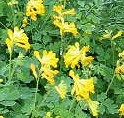 Corydalis is an herbaceous annual or perennial belonging to the poppy family (Papaveraceae) and related to bleeding hearts (Dicentra spp.) It is represented by over 400 species that are native to the Northern hemisphere with over 300 species in China. The asymmetrical flowers have four petals, the outer two larger, one of them spurred. The foliage forms a leafy mound of pinnately compound, fern-like leaves. Plants like shade and consistently moist, well-drained soil and most species do not tolerate heat well. The genus name, Corydalis, comes from the Greek word korydalis meaning lark and refers to the spurs on the petals that are thought to resemble the spurs of some larks.
Corydalis is an herbaceous annual or perennial belonging to the poppy family (Papaveraceae) and related to bleeding hearts (Dicentra spp.) It is represented by over 400 species that are native to the Northern hemisphere with over 300 species in China. The asymmetrical flowers have four petals, the outer two larger, one of them spurred. The foliage forms a leafy mound of pinnately compound, fern-like leaves. Plants like shade and consistently moist, well-drained soil and most species do not tolerate heat well. The genus name, Corydalis, comes from the Greek word korydalis meaning lark and refers to the spurs on the petals that are thought to resemble the spurs of some larks.
Here are some outstanding Corydalis species. Most are difficult to find in the US.
C. lutea
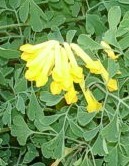 Also called yellow fumitory, this perennial is the mostly commonly grown Corydalis in the US but is native to the foothills of the southern Alps in Switzerland, Italy, and Yugoslavia where it grows on shady rocks and screes. The golden yellow flowers are ¾ inches long and carried in dense elongated racemes over a long bloom time beginning in May . The three to four times pinnate foliage is distinctly three-lobed and forms a neat mound. The plant spreads easily by seed and may pop up in unexpected places.
Also called yellow fumitory, this perennial is the mostly commonly grown Corydalis in the US but is native to the foothills of the southern Alps in Switzerland, Italy, and Yugoslavia where it grows on shady rocks and screes. The golden yellow flowers are ¾ inches long and carried in dense elongated racemes over a long bloom time beginning in May . The three to four times pinnate foliage is distinctly three-lobed and forms a neat mound. The plant spreads easily by seed and may pop up in unexpected places.
Height: 12-15”
Color: Golden yellow
Hardiness: Zone 5-7
C. flexuosa
Commonly known as blue corydalis, this rhizomatous perennial is native to China where it grows on steep shady slopes and flowers in April and July. The blue flowers have long spurs and are carried in dense racemes on slender stems. The racemes have up to ten flowers and may be up to three inches long. Each flower is one inch long and has a whitish throat. The leaves are finely divided and up to six inches long. Plants do not like the heat and may go dormant during the summer sometimes reappearing in the fall to bloom again. They are also known for their finicky nature and may disappear entirely for no apparent reason. Well known cultivars 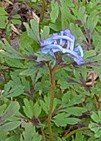 are “Blue Panda’ and ‘Pere David’
are “Blue Panda’ and ‘Pere David’
Height: 12-18”
Color: Blue
Hardiness: Zones 5-8
C. solida
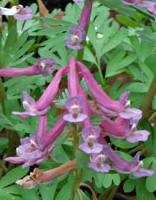 Native to moist shady areas of northern Europe and Asia, this spring ephemeral has a tuberous root system and dies down after blooming. The mauve, purple, red, or white flowers are up to one inch long and carried in clusters of up to twenty in spring. The foliage is medium green, deeply divided, and fernlike.
Native to moist shady areas of northern Europe and Asia, this spring ephemeral has a tuberous root system and dies down after blooming. The mauve, purple, red, or white flowers are up to one inch long and carried in clusters of up to twenty in spring. The foliage is medium green, deeply divided, and fernlike.
Height:6-12”
Color: Mauve, red, purple, white
Hardiness: Zones 4-8
C. nobilis
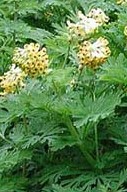 Notable for its large size and hardiness this herbaceous perennial is native to Siberia, China, and Mongolia where it grows in scrub and grassy places near streams in the mountains and blooms in April and May. For two to three weeks. If conditions are dry the plant goes dormant by mid-summer. The leaves are pinnate to bipinnate and have lobed leaflets. The fragrant flowers are golden yellow with purple spurs and are carried in dense, compact, long stalked racemes of up to forty.
Notable for its large size and hardiness this herbaceous perennial is native to Siberia, China, and Mongolia where it grows in scrub and grassy places near streams in the mountains and blooms in April and May. For two to three weeks. If conditions are dry the plant goes dormant by mid-summer. The leaves are pinnate to bipinnate and have lobed leaflets. The fragrant flowers are golden yellow with purple spurs and are carried in dense, compact, long stalked racemes of up to forty.
Height: 2’
Color: Golden yellow with purple spur
Hardiness: Zones 3-8
C. shaereri
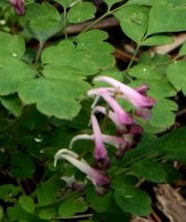 This native of China grows in shady woodlands and blooms in April and May. It has a rhizome and underground branching stolons that produce a rosette of compound leaves with short leaflets. The flowers have upward facing spurs and are produced in terminal racemes. They are ¾ inch long and purplish when they open but fade to buff.
This native of China grows in shady woodlands and blooms in April and May. It has a rhizome and underground branching stolons that produce a rosette of compound leaves with short leaflets. The flowers have upward facing spurs and are produced in terminal racemes. They are ¾ inch long and purplish when they open but fade to buff.
Height: 16”
Color: Purple to buff
Hardiness: Zones 6-7?
C. ochroleuca aka Pseudofumaria alba
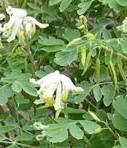 Also called white corydalis, this short-lived evergreen herbaceous perennial is native to Italy and the Balkans where it grows in rocky woodlamds and flowers from May to September. The leaves are pinnate, finely-divided and blue-green. The fragrant, tubular flowers are 5/8″ long, carried in axillary racemes of up to fourteen, and are creamy white with pale yellow throat.
Also called white corydalis, this short-lived evergreen herbaceous perennial is native to Italy and the Balkans where it grows in rocky woodlamds and flowers from May to September. The leaves are pinnate, finely-divided and blue-green. The fragrant, tubular flowers are 5/8″ long, carried in axillary racemes of up to fourteen, and are creamy white with pale yellow throat.
Height: 12-20”
Color: Creamy white with pale yellow throat
Hardiness: Zones 5-7
C. elata
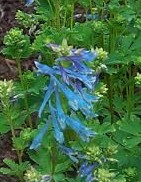 Considered by many to be the best blue corydalis, this evergreen herbaceous perennial native to southwest China is more heat tolerant than most and does not go dormant in the summer. The foliage is lacy yellow-green while the fragrant flowers are true blue.
Considered by many to be the best blue corydalis, this evergreen herbaceous perennial native to southwest China is more heat tolerant than most and does not go dormant in the summer. The foliage is lacy yellow-green while the fragrant flowers are true blue.
Height: 1-3’
Color: Blue
Hardiness: Zones 5-9